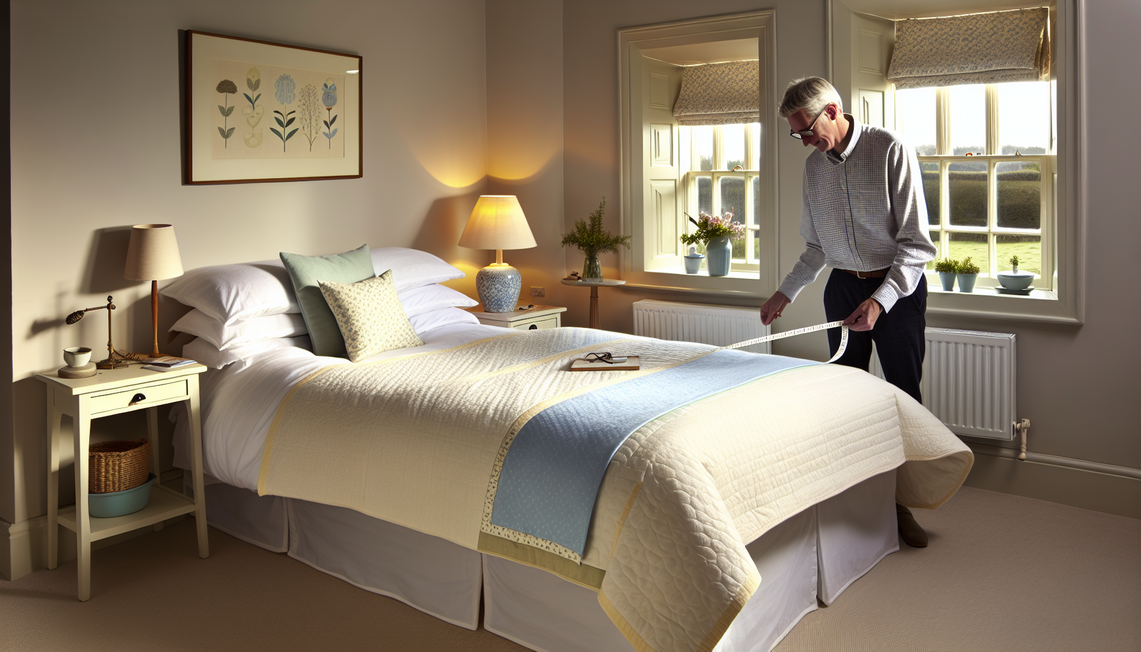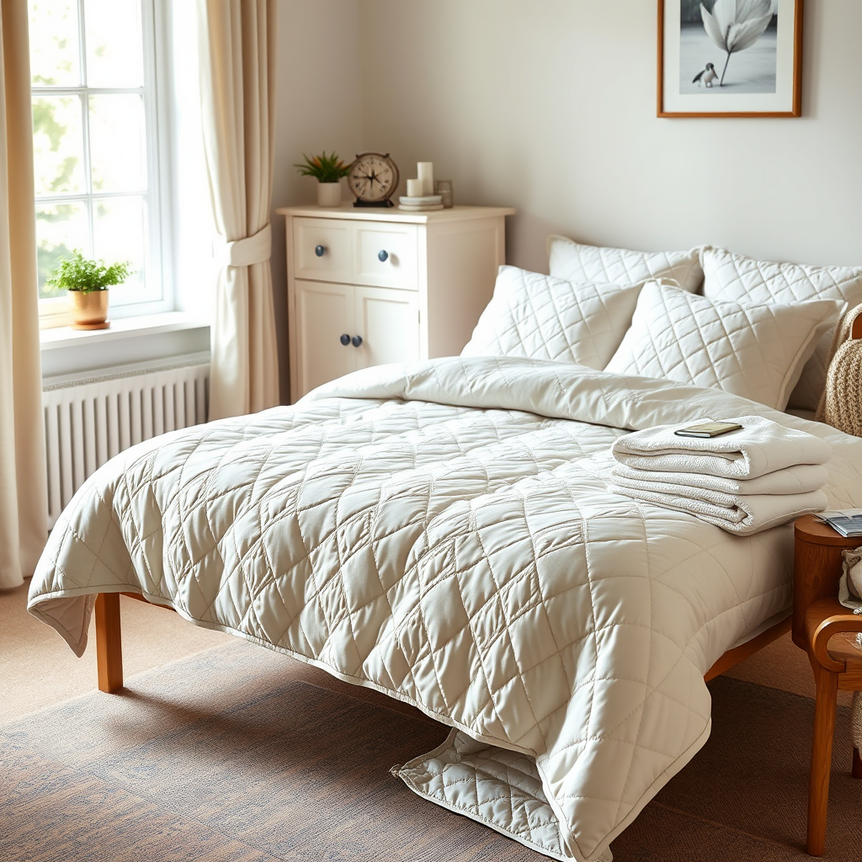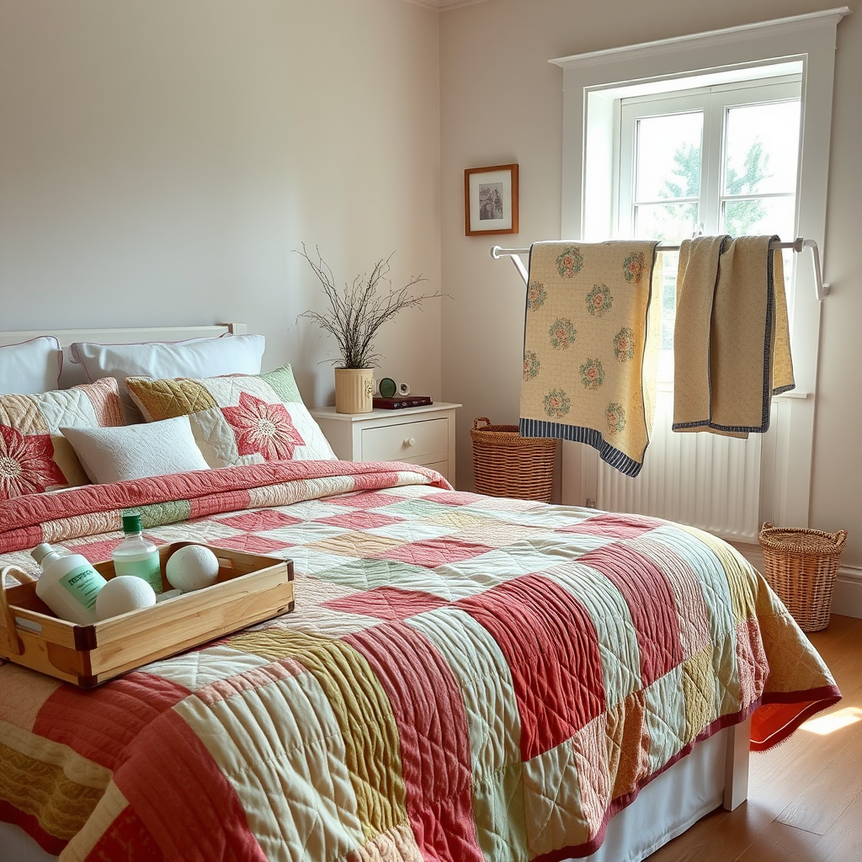Choosing the right quilt size is essential for achieving optimum comfort, aesthetic appeal, and longevity of your bedding. In the UK, varying standards and personal preferences mean selecting the perfect quilt size can sometimes feel confusing. This comprehensive guide will help you understand UK quilt sizes, crucial measurement variations, and practical tips tailored to your bedroom needs, ensuring you make an informed choice for your home and enhance your sleep quality. Whether you’re looking for standard quilt dimensions or custom bedding measurements, we’ve got you covered.
Why Choosing the Right Quilt Size Matters for Your Home Comfort
Selecting the right quilt size goes beyond simply matching it to your bed dimensions; it’s a fundamental aspect of creating a truly comfortable and inviting bedroom environment. An appropriately sized quilt offers numerous benefits:
- Enhances Comfort: Provides adequate coverage and warmth, ensuring no cold spots or uncomfortable drafts during the night. The correct quilt overhang contributes to an enveloping, cosy feeling.
- Maintains Style and Aesthetics: A well-fitted quilt or duvet complements your existing bedding style and bedroom décor, creating a cohesive and polished look. An ill-fitting quilt can make your bed appear dishevelled or disproportionate.
- Protects Your Bedding: Prevents excessive wear and tear on your quilt and duvet cover by reducing unnecessary drag on the floor or constant readjustment, which can strain fabrics.
- Improves Sleep Quality: A quilt that fits perfectly avoids frustrating bunching, slipping, or constant readjustment throughout the night, leading to more restful and uninterrupted sleep.
Incorrect sizing—whether a quilt is too small or excessively large—can lead to discomfort, reduced thermal efficiency, and an unappealing, untidy appearance for your bed. Understanding standard quilt sizes for UK beds is the first first step towards perfect bedding.
Understanding Standard UK Quilt Sizes: Measurements and Variations Explained
UK quilts come in standard sizes meticulously designed to align with typical bed dimensions found across the country. However, it’s important to note that slight variations can exist across different manufacturers, making it key to always check the approximate measurements for each size before purchasing your new bedding. Here are the commonly accepted standard quilt dimensions for the UK:
| Quilt Size | Approximate Dimensions (cm) | Approximate Dimensions (inches) |
|---|---|---|
| Single Quilt | 135 x 200 | 53 x 79 |
| Double Quilt | 200 x 200 | 79 x 79 |
| King Size Quilt | 225 x 220 | 89 x 87 |
| Super King Quilt | 260 x 220 | 102 x 87 |
Note: While these duvet dimensions are widely accepted, some quilted bedspreads may have slight adjustments (+/- 5 cm) to allow for a more generous overhang or for specific aesthetic purposes. Always consult the product specifications when purchasing to ensure an accurate fit for your bed.
Comparing UK Quilt Sizes with International Standards: What UK Consumers Should Know
For UK consumers, understanding the differences between domestic and international quilt sizes is crucial, especially if you’re exploring options from global retailers or have previously purchased bedding from abroad. Quilt sizes can differ significantly, and an international \”King\” size might not be the same as a UK King size quilt.
- US Quilt Sizes: Generally, US quilt and duvet sizes tend to be slightly larger than their UK counterparts, particularly in width. For instance, a US \”King\” quilt is often broader than a UK King size quilt, which could result in too much drape or an ill-fitting duvet cover if you’re not careful.
- European Sizes: European bedding measurements can vary more widely between countries. Some European quilts might be more rectangular or square compared to standard UK dimensions, which are typically more standardised.
- Australian Sizes: Similar to US sizes, Australian bedding often runs a little larger than UK dimensions.
This information is vital if you’re cross-shopping or replacing quilts or duvet covers imported from abroad. Always check the exact product measurements and compare them directly with your bed size to avoid the inconvenience of ill-fitting bedding. Opting for quilted bedspreads designed specifically for UK beds simplifies the process and ensures a perfect fit.
Step-by-Step Guide: How to Accurately Measure for Your Perfect Quilt Size
Choosing the correct quilt size begins with accurate measurements. Follow these steps to ensure you select a quilt that perfectly complements your bed and personal preferences:
- Measure Your Mattress: Start by measuring the exact length and width of your mattress. Do this without any existing bedding or protectors on the bed to get the most precise dimensions. Note down your mattress width and length.
- Decide Your Desired Overhang: The quilt overhang is the amount of quilt that drapes over the sides and foot of your bed. Typically, a drop of 30-50 cm on each side is considered comfortable and visually pleasing. For a more luxurious look, or if you have a deep mattress, you might prefer a greater overhang.
- Calculate Quilt Dimensions: Using your mattress measurements and desired overhang, calculate the ideal quilt dimensions:
- Width: Mattress width + (2 x desired side overhang). For example, if your mattress is 150 cm wide and you want a 40 cm overhang on each side, you’d need a quilt approximately 230 cm wide (150 + 40 + 40).
- Length: Mattress length + (desired overhang at the foot). The head overhang can be less if you use pillows to cover the top of the bed. For example, a 200 cm long mattress with a 30 cm foot overhang would need a quilt approximately 230 cm long (200 + 30).
- Consider Bed Height and Frame: If you have a high divan bed, a particularly deep mattress, or a bed frame with significant side rails, you may require a longer or wider quilt to ensure adequate coverage and prevent the mattress or frame from showing.
- Allow for Personal Preferences: Some individuals prefer a quilt that tucks neatly under the pillows, while others favour a generous drape that almost touches the floor. Factor in whether you share your bed and if more coverage is needed for two sleepers.
By following these steps, you can confidently determine the ideal bedding measurements for your home.
Tailoring Quilt Sizes to Different Bed Types in the UK: Single, Double, King, and Super King
Each standard UK bed type requires a specific quilt size for optimal comfort, coverage, and aesthetic appeal. Matching your quilt to your bed is key to a well-dressed bed.
- Single Beds: A standard single quilt size (typically 135 x 200 cm) is perfectly suited for single beds. These are ideal for children’s rooms, guest beds, or smaller bedrooms, providing ample coverage without excess bulk. A single duvet ensures a snug and comfortable sleep for one person.
- Double Beds: A double quilt (approximately 200 x 200 cm) fits neatly on a standard double bed, providing sufficient overhang on each side for two sleepers. This size offers balanced coverage and warmth, making it the most common choice for couples.
- King Beds: For larger double beds, common in master bedrooms, a king size quilt (225 x 220 cm) provides wider and more generous coverage. This extra width is particularly beneficial for couples who prefer more individual quilt space or for achieving a luxurious, draped look.
- Super King Beds: The super king quilt size (260 x 220 cm) is designed to ensure total coverage for the widest UK beds. This ensures maximum comfort and maintains a luxurious, grand feel, offering abundant drape and warmth even for two people. A super king duvet size is the ultimate choice for spacious sleeping.
Selecting quilted bedspreads tailored to your bed type helps avoid awkward gaps, insufficient warmth, or excess bulk that can detract from your bedroom’s overall aesthetic and your sleep comfort.
Practical Tips for Selecting Quilt Sizes Based on Bedroom Style and Personal Preference
Beyond the standard measurements, your bedroom’s style and your personal comfort preferences play a significant role in choosing the perfect quilt size. Consider these practical tips to refine your selection:
- Room Size & Décor: In smaller rooms, an excessively large quilt with too much overhang can make the space feel cramped and cluttered. Opt for a neat, personalised fit that complements the room’s proportions. Conversely, a generous super king quilt can enhance the grandeur of a spacious master bedroom.
- Seasonal Changes & Layering: Think about how you use your bedding throughout the year. You might opt for a standard size for your main quilt but consider layering with smaller throws or a lighter quilted bedspread for warmer months. The right duvet dimensions can accommodate additional layers if desired.
- Material Type and Weight: The material and fill of your quilt can influence how it drapes. Heavier quilts, such as those with dense quilting or a velvet finish, might feel overwhelming if oversized. Lighter, more fluid materials may benefit from a slightly larger size for a luxurious drape.
- Matching Sets & Cohesion: For a seamlessly coordinated look, ensure your quilt size works well with other elements of your bedding, such as pillowcases, bed throws, and fitted or flat sheets. Many UK quilt sizes are designed to pair perfectly with standard pillow sizes.
- Deep Mattresses or Mattress Toppers: If you have a particularly deep mattress (e.g., 30cm or more) or use a thick mattress topper, you might find that a standard quilt for your bed size doesn’t provide enough side overhang. In such cases, considering the next size up (e.g., a King quilt for a Double bed) can provide the desired coverage.
For those looking to explore a selection of high-quality, perfectly sized quilted bedspreads designed to meet UK standards, we invite you to visit Rugstars UK’s collection of quilted bedspreads. Our range offers a variety of designs and standard UK quilt sizes to enhance any bedroom style.
Frequently Asked Questions About Quilt Sizes in the UK: Expert Answers for Common Concerns
Here are some of the most common questions UK shoppers have when choosing quilt sizes, along with expert answers to help you make an informed decision:
- Q: Can I use a Double quilt on a King bed?
A: While technically possible, it is generally not ideal. A double quilt (200x200cm) will likely not provide enough side coverage on a king bed (150cm wide mattress), leaving gaps and affecting both warmth and the aesthetic appeal of your bed. For optimal comfort and look, always choose a king size quilt for a king bed. - Q: Are quilt sizes labelled consistently across UK brands?
A: Most reputable UK brands adhere closely to the standard quilt dimensions provided in this guide. However, minor variations (+/- 5cm) can occur due to manufacturing processes or specific design choices. It is always best to check the exact dimensions listed in the product specifications before making a purchase. - Q: How much overhang is considered standard for a quilt?
A: An overhang of approximately 30-50 cm (12-20 inches) on each side and at the foot of the bed is typically considered standard and provides a good balance of coverage and aesthetic drape. However, personal preference, the depth of your mattress, and the height of your bed frame will influence what looks and feels best for you. - Q: What’s the difference between a quilt and a duvet, in terms of size?
A: In the UK, the terms \”quilt\” and \”duvet\” are often used interchangeably to refer to the inner bedding that provides warmth, covered by a duvet cover. Therefore, their standard sizes are generally the same (e.g., a UK Single Quilt is the same size as a UK Single Duvet). \”Quilted bedspreads,\” however, might sometimes be slightly larger to act as a decorative top layer. - Q: Do I need a larger quilt if I have a very deep mattress or mattress topper?
A: Yes, if you have a particularly deep mattress (e.g., 30cm or more) or use a thick mattress topper, you might find that a standard quilt for your bed size doesn’t provide the desired side overhang. In such cases, considering the next size up (e.g., a King quilt for a Double bed, or a Super King for a King bed) can ensure better coverage and a more luxurious drape. Always measure your mattress with the topper for accurate bedding measurements.
Choosing the right quilt size is a simple yet significant step that profoundly enhances your bedroom’s comfort, style, and your overall sleep experience. Use this guide to measure accurately, understand UK standards, and confidently pick the perfect quilt that fits your lifestyle and bed type, ensuring truly restful nights. For a curated collection of UK-standard quilt sizes and designs, explore Rugstars’ selection of high-quality quilted bedspreads, crafted for comfort and style.



